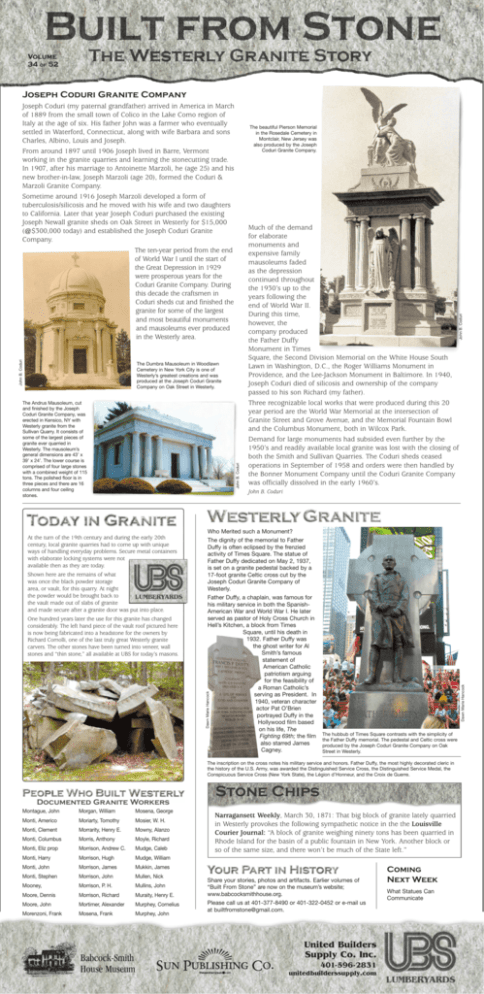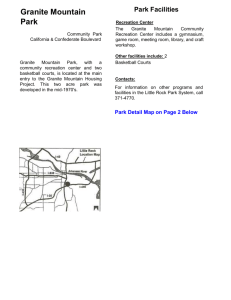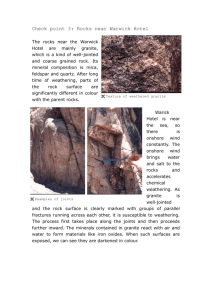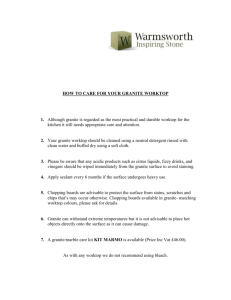The Joseph Coduri Granite Company - Babcock
advertisement

Volume 34 of 52 Joseph Coduri Granite Company John B. Coduri Joseph Coduri (my paternal grandfather) arrived in America in March of 1889 from the small town of Colico in the Lake Como region of Italy at the age of six. His father John was a farmer who eventually settled in Waterford, Connecticut, along with wife Barbara and sons Charles, Albino, Louis and Joseph. From around 1897 until 1906 Joseph lived in Barre, Vermont working in the granite quarries and learning the stonecutting trade. In 1907, after his marriage to Antoinette Marzoli, he (age 25) and his new brother-in-law, Joseph Marzoli (age 20), formed the Coduri & Marzoli Granite Company. Sometime around 1916 Joseph Marzoli developed a form of tuberculosis/silicosis and he moved with his wife and two daughters to California. Later that year Joseph Coduri purchased the existing Joseph Newall granite sheds on Oak Street in Westerly for $15,000 (@$300,000 today) and established the Joseph Coduri Granite Company. The ten-year period from the end of World War I until the start of the Great Depression in 1929 were prosperous years for the Coduri Granite Company. During this decade the craftsmen in Coduri sheds cut and finished the granite for some of the largest and most beautiful monuments and mausoleums ever produced in the Westerly area. The Dumbra Mausoleum in Woodlawn Cemetery in New York City is one of Westerly’s greatest creations and was produced at the Joseph Coduri Granite Company on Oak Street in Westerly. John B. Coduri The Andrus Mausoleum, cut and finished by the Joseph Coduri Granite Company, was erected in Kensico, NY with Westerly granite from the Sullivan Quarry. It consists of some of the largest pieces of granite ever quarried in Westerly. The mausoleum’s general dimensions are 43’ x 39’ x 24’. The lower course is comprised of four large stones with a combined weight of 115 tons. The polished floor is in three pieces and there are 16 columns and four ceiling stones. Much of the demand for elaborate monuments and expensive family mausoleums faded as the depression continued throughout the 1930’s up to the years following the end of World War II. During this time, however, the company produced the Father Duffy Monument in Times Square, the Second Division Memorial on the White House South Lawn in Washington, D.C., the Roger Williams Monument in Providence, and the Lee-Jackson Monument in Baltimore. In 1940, Joseph Coduri died of silicosis and ownership of the company passed to his son Richard (my father). Three recognizable local works that were produced during this 20 year period are the World War Memorial at the intersection of Granite Street and Grove Avenue, and the Memorial Fountain Bowl and the Columbus Monument, both in Wilcox Park. Demand for large monuments had subsided even further by the 1950’s and readily available local granite was lost with the closing of both the Smith and Sullivan Quarries. The Coduri sheds ceased operations in September of 1958 and orders were then handled by the Bonner Monument Company until the Coduri Granite Company was officially dissolved in the early 1960’s. John B. Coduri The beautiful Pierson Memorial in the Rosedale Cemetery in Montclair, New Jersey was also produced by the Joseph Coduri Granite Company. John B. Coduri Who Merited such a Monument? Shown here are the remains of what was once the black powder storage area, or vault, for this quarry. At night the powder would be brought back to the vault made out of slabs of granite and made secure after a granite door was put into place. Father Duffy, a chaplain, was famous for his military service in both the SpanishAmerican War and World War I. He later served as pastor of Holy Cross Church in Hell’s Kitchen, a block from Times Square, until his death in 1932. Father Duffy was the ghost writer for Al Smith’s famous statement of American Catholic patriotism arguing for the feasibility of a Roman Catholic’s serving as President. In 1940, veteran character actor Pat O’Brien portrayed Duffy in the Hollywood film based on his life, The Fighting 69th; the film also starred James Cagney. Dawn Marie Hancock One hundred years later the use for this granite has changed considerably. The left hand piece of the vault roof pictured here is now being fabricated into a headstone for the owners by Richard Comolli, one of the last truly great Westerly granite carvers. The other stones have been turned into veneer, wall stones and “thin stone,” all available at UBS for today’s masons. The dignity of the memorial to Father Duffy is often eclipsed by the frenzied activity of Times Square. The statue of Father Duffy dedicated on May 2, 1937, is set on a granite pedestal backed by a 17-foot granite Celtic cross cut by the Joseph Coduri Granite Company of Westerly. Dawn Marie Hancock At the turn of the 19th century and during the early 20th century, local granite quarries had to come up with unique ways of handling everyday problems. Secure metal containers with elaborate locking systems were not available then as they are today. The hubbub of Times Square contrasts with the simplicity of the Father Duffy memorial. The pedestal and Celtic cross were produced by the Joseph Coduri Granite Company on Oak Street in Westerly. The inscription on the cross notes his military service and honors. Father Duffy, the most highly decorated cleric in the history of the U.S. Army, was awarded the Distinguished Service Cross, the Distinguished Service Medal, the Conspicuous Service Cross (New York State), the Légion d’Honneur, and the Croix de Guerre. Stone Chips Documented Granite Workers Montague, John Morgan, William Mosena, George Monti, Americo Moriarty, Tomothy Mosier, W. H. Monti, Clement Morrarity, Henry E. Mowny, Alanzo Monti, Columbus Morris, Anthony Moyle, Richard Monti, Eliz prop Morrison, Andrew C. Mudge, Caleb Monti, Harry Morrison, Hugh Mudge, William Monti, John Morrison, James Mukkin, James Monti, Stephen Morrison, John Mullen, Nick Mooney, Morrison, P. H. Mullins, John Moore, Dennis Morrison, Richard Muraity, Henry E. Moore, John Mortimer, Alexander Murphey, Cornelius Morenzoni, Frank Mosena, Frank Murphey, John Babcock-Smith House Museum Narragansett Weekly, March 30, 1871: That big block of granite lately quarried in Westerly provokes the following sympathetic notice in the the Louisville Courier Journal: “A block of granite weighing ninety tons has been quarried in Rhode Island for the basin of a public fountain in New York. Another block or so of the same size, and there won’t be much of the State left.” Share your stories, photos and artifacts. Earlier volumes of “Built From Stone” are now on the museum’s website; www.babcocksmithhouse.org. Please call us at 401-377-8490 or 401-322-0452 or e-mail us at builtfromstone@gmail.com. United Builders Supply Co. Inc. 401-596-2831 unitedbuilderssupply.com Coming Next Week What Statues Can Communicate







